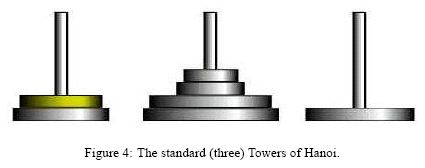POJ1958 Strange Towers of Hanoi [递推]
Strange Towers of Hanoi
| Time Limit: 1000MS | Memory Limit: 30000K | |
| Total Submissions: 3117 | Accepted: 2004 |
Description
Background
Charlie Darkbrown sits in another one of those boring Computer Science lessons: At the moment the teacher just explains the standard Tower of Hanoi problem, which bores Charlie to death!

The teacher points to the blackboard (Fig. 4) and says: "So here is the problem:
So your task is to write a program that calculates the smallest number of disk moves necessary to move all the disks from tower A to C."
Charlie: "This is incredibly boring—everybody knows that this can be solved using a simple recursion.I deny to code something as simple as this!"
The teacher sighs: "Well, Charlie, let's think about something for you to do: For you there is a fourth tower D. Calculate the smallest number of disk moves to move all the disks from tower A to tower D using all four towers."
Charlie looks irritated: "Urgh. . . Well, I don't know an optimal algorithm for four towers. . . "
Problem
So the real problem is that problem solving does not belong to the things Charlie is good at. Actually, the only thing Charlie is really good at is "sitting next to someone who can do the job". And now guess what — exactly! It is you who is sitting next to Charlie, and he is already glaring at you.
Luckily, you know that the following algorithm works for n <= 12: At first k >= 1 disks on tower A are fixed and the remaining n-k disks are moved from tower A to tower B using the algorithm for four towers.Then the remaining k disks from tower A are moved to tower D using the algorithm for three towers. At last the n - k disks from tower B are moved to tower D again using the algorithm for four towers (and thereby not moving any of the k disks already on tower D). Do this for all k 2 ∈{1, .... , n} and find the k with the minimal number of moves.
So for n = 3 and k = 2 you would first move 1 (3-2) disk from tower A to tower B using the algorithm for four towers (one move). Then you would move the remaining two disks from tower A to tower D using the algorithm for three towers (three moves). And the last step would be to move the disk from tower B to tower D using again the algorithm for four towers (another move). Thus the solution for n = 3 and k = 2 is 5 moves. To be sure that this really is the best solution for n = 3 you need to check the other possible values 1 and 3 for k. (But, by the way, 5 is optimal. . . )
Charlie Darkbrown sits in another one of those boring Computer Science lessons: At the moment the teacher just explains the standard Tower of Hanoi problem, which bores Charlie to death!

The teacher points to the blackboard (Fig. 4) and says: "So here is the problem:
- There are three towers: A, B and C.
- There are n disks. The number n is constant while working the puzzle.
- All disks are different in size.
- The disks are initially stacked on tower A increasing in size from the top to the bottom.
- The goal of the puzzle is to transfer all of the disks from tower A to tower C.
- One disk at a time can be moved from the top of a tower either to an empty tower or to a tower with a larger disk on the top.
So your task is to write a program that calculates the smallest number of disk moves necessary to move all the disks from tower A to C."
Charlie: "This is incredibly boring—everybody knows that this can be solved using a simple recursion.I deny to code something as simple as this!"
The teacher sighs: "Well, Charlie, let's think about something for you to do: For you there is a fourth tower D. Calculate the smallest number of disk moves to move all the disks from tower A to tower D using all four towers."
Charlie looks irritated: "Urgh. . . Well, I don't know an optimal algorithm for four towers. . . "
Problem
So the real problem is that problem solving does not belong to the things Charlie is good at. Actually, the only thing Charlie is really good at is "sitting next to someone who can do the job". And now guess what — exactly! It is you who is sitting next to Charlie, and he is already glaring at you.
Luckily, you know that the following algorithm works for n <= 12: At first k >= 1 disks on tower A are fixed and the remaining n-k disks are moved from tower A to tower B using the algorithm for four towers.Then the remaining k disks from tower A are moved to tower D using the algorithm for three towers. At last the n - k disks from tower B are moved to tower D again using the algorithm for four towers (and thereby not moving any of the k disks already on tower D). Do this for all k 2 ∈{1, .... , n} and find the k with the minimal number of moves.
So for n = 3 and k = 2 you would first move 1 (3-2) disk from tower A to tower B using the algorithm for four towers (one move). Then you would move the remaining two disks from tower A to tower D using the algorithm for three towers (three moves). And the last step would be to move the disk from tower B to tower D using again the algorithm for four towers (another move). Thus the solution for n = 3 and k = 2 is 5 moves. To be sure that this really is the best solution for n = 3 you need to check the other possible values 1 and 3 for k. (But, by the way, 5 is optimal. . . )
Input
There is no input.
Output
For each n (1 <= n <= 12) print a single line containing the minimum number of moves to solve the problem for four towers and n disks.
Sample Input
- No input.
Sample Output
REFER TO OUTPUT.
分析:题目大意就是要求你解出n个盘子4座塔的Hanoi问题的最少步数,不需要输入,直接输出n为1-12的所有答案即可。我们知道,一般的三塔Hanoi问题的递推式是d[i]=d[i-1]*2+1,意思就是先将i-1个盘子放在第二个塔上,再把最后一个放在第三个塔上,再将i-1个盘子放在第三个塔上(如果这个不知道就自己去玩一下Hanoi),当然这种方法实质上是将i个盘子的问题先转化为i-1个盘子的问题。那么做这题就可以用类似的思维,先将i个盘子的四塔问题转化为j个盘子的三塔问题(0<=j<=i),令f[i]为i个盘子的四塔问题的答案,则f[i]=min(f[i],f[j]*2+d[i-j])。实际上也就等效于先做j个盘子的四塔问题,再做i-j个盘子的三塔问题,再做一次j个盘子的四塔问题。那么答案就很容易了。
Code:
- #include<cstdio>
- #include<cstring>
- #include<cstdlib>
- #include<cmath>
- #include<iostream>
- #include<iomanip>
- #include<algorithm>
- #define Fi(i,a,b) for(int i=a;i<=b;i++)
- using namespace std;
- int d[13],f[13];
- int main()
- {
- Fi(i,1,12)d[i]=d[i-1]*2+1;memset(f,0x3f3f3f3f,sizeof(f));
- f[1]=1;Fi(i,2,12)Fi(j,1,i)f[i]=min(f[i],2*f[j]+d[i-j]);
- Fi(i,1,12)cout<<f[i]<<endl;return 0;
- }
蒟蒻写博客不易,如果有误还请大佬们提出
如需转载,请署名作者并附上原文链接,蒟蒻非常感激
名称:HolseLee
博客地址:www.cnblogs.com/cytus
个人邮箱:1073133650@qq.com
如需转载,请署名作者并附上原文链接,蒟蒻非常感激
名称:HolseLee
博客地址:www.cnblogs.com/cytus
个人邮箱:1073133650@qq.com
分类:
基础算法——递推/递归
, (>.<)emmm...刷题记录
标签:
POJ





【推荐】编程新体验,更懂你的AI,立即体验豆包MarsCode编程助手
【推荐】凌霞软件回馈社区,博客园 & 1Panel & Halo 联合会员上线
【推荐】抖音旗下AI助手豆包,你的智能百科全书,全免费不限次数
【推荐】博客园社区专享云产品让利特惠,阿里云新客6.5折上折
【推荐】轻量又高性能的 SSH 工具 IShell:AI 加持,快人一步
· DeepSeek 解答了困扰我五年的技术问题
· 为什么说在企业级应用开发中,后端往往是效率杀手?
· 用 C# 插值字符串处理器写一个 sscanf
· Java 中堆内存和栈内存上的数据分布和特点
· 开发中对象命名的一点思考
· DeepSeek 解答了困扰我五年的技术问题。时代确实变了!
· PPT革命!DeepSeek+Kimi=N小时工作5分钟完成?
· What?废柴, 还在本地部署DeepSeek吗?Are you kidding?
· DeepSeek企业级部署实战指南:从服务器选型到Dify私有化落地
· 程序员转型AI:行业分析